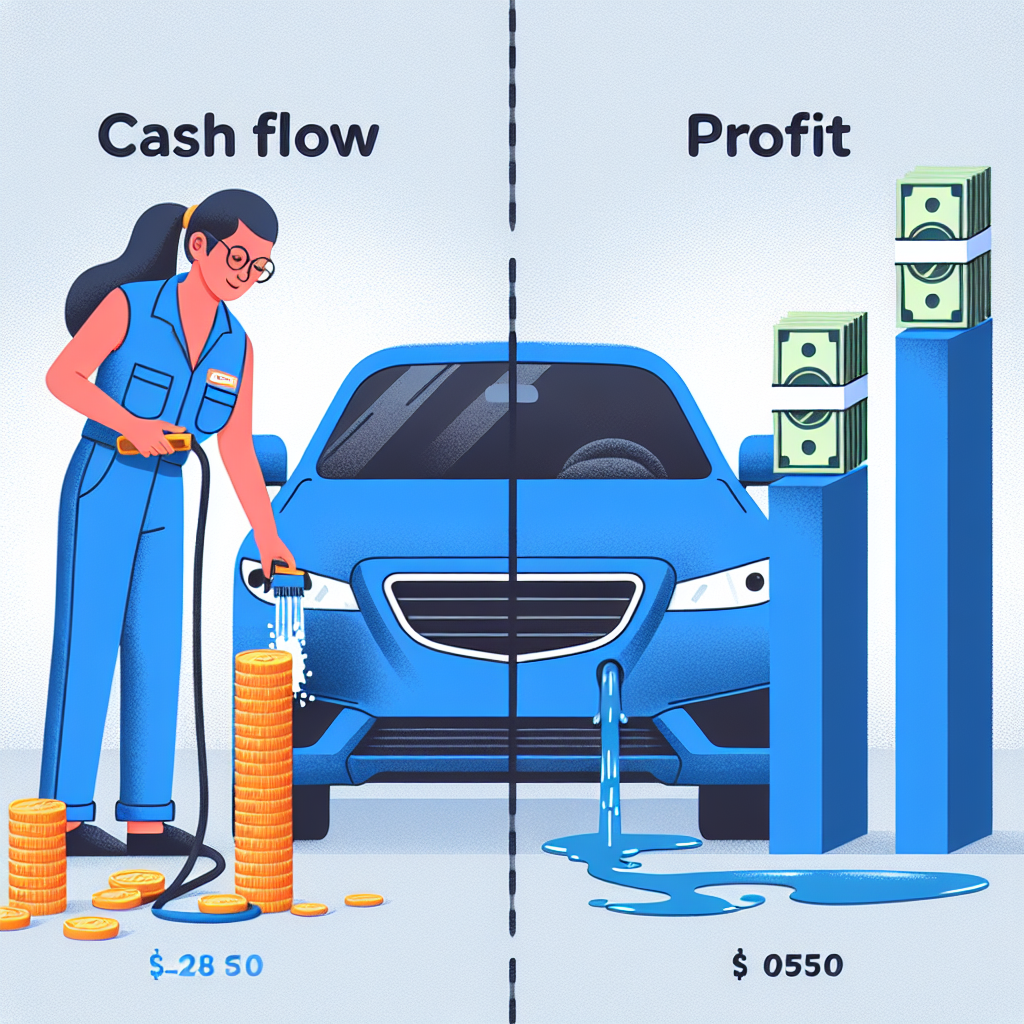Understanding the Difference between Cash Flow and Profit
Defining Cash Flow
First off, let’s get into what cash flow really means. When I started my auto detailing business, I used to think that cash flow and profit were interchangeable. But let me tell you, they are not! Cash flow refers to the actual money coming in and out of your business. You might have all the sales in the world, but if you’re not receiving payments on time, your cash flow could take a hit.
I learned the hard way that positive cash flow means having enough money to cover your business’s short-term obligations. This means paying for materials, labor, and those pesky utility bills. It’s about the timing of when you receive payments compared to when you have to pay your expenses.
Simplifying it, think of cash flow as the lifeblood of your business. If you’re flowing smoothly, you can take on more jobs, buy better equipment, and maybe even treat yourself every now and then. Without it, you’re stuck in a muddy puddle.
Defining Profit
Now, profit is a bit of a different creature. It’s what’s left over after you’ve paid all your expenses. Initially, I was stoked at how much revenue my detailing shop was bringing in, but it sure took me a while to grasp how expenses could eat into my profit like hungry termites!
Profit can be calculated in a couple of ways—gross profit and net profit. Gross profit is essentially your revenue minus the costs of goods sold. On the flip side, net profit takes into account all other expenses, such as salaries, rent, and marketing costs. Focusing solely on profit without considering the cash flow can lead to dangerous misconceptions about the health of your business.
Keeping a pulse on your profit is crucial because it reflects the financial health of your business over a longer period. If you’re constantly seeing profits but struggling to pay the bills, you might just be in trouble. You can’t eat profit, but you sure can use cash flow to pay for that food!
Indicators of Cash Flow and Profit
As an auto detailing business owner, I’ve come to rely on key indicators to keep track of both cash flow and profit. For cash flow, I typically look at accounts receivable and accounts payable. If my receivables are high and my payables are too, it might be time to start chasing those payments while being careful about spending.
On the profit side, the gross margin percentage is something I’ve learned to analyze closely. It tells me how much of each dollar I’m keeping after the direct costs. If this number starts to drop, it means I need to reassess my pricing strategy or look into reducing costs without compromising quality.
In a nutshell, both metrics are vital, but they tell different stories. Cash flow can keep you afloat, while profit can set you up for growth. It’s the balance of both that keeps my business thriving!
Importance of Cash Flow Management
Keeping the Doors Open
Managing cash flow has become one of my key focuses in my business. It’s not just about making the sale; it’s about timing the payments. Remember that dollar you made last week doesn’t mean much if it’s stuck with a customer who takes their sweet time to pay!
I’ve found that implementing effective invoicing practices can dramatically improve my cash flow. Sending timely invoices and having clear terms allow me to collect payments faster. Plus, I also keep my clients very much in the loop regarding payment expectations, which builds trust and makes future transactions smoother.
If you can nail down your cash flow, you’ll have the flexibility to handle unexpected expenses. Whether that’s fixing your vacuum machine or splurging on new detailing products, knowing your cash is in good shape gives you peace of mind!
Planning for Seasonal Variations
In detailing, we have our busy seasons and our slow ones. Preparing for the slow months is like planning for winter; you stock up and make sure you don’t run out of resources. Establishing a strategic cash reserve can help cushion you during lean times.
I usually look at my previous years’ revenues to predict slow months. If I know January tends to be quiet, I plan accordingly. Cutting unnecessary expenses in advance or offering seasonal promotions allows me to keep cash flowing even when business is slow.
Building seasonal strategies not only keeps the cash flow healthy but can create customer loyalty, as you might incentivize clients to come back during off-peak times.
Investing Back into the Business
Understanding cash flow allows for strategic investments in your auto detailing business. Once I learned the importance of managing my cash flow, I found that I could reinvest into better equipment, which in turn increased my efficiency and quality.
Consider allocating a portion of your cash flow for growth. Whether it’s for extra marketing during busy months or upgrading your tools, these investments not only boost your cash flow in the long run but also enhance your reputation.
Reinvesting in yourself and your business is an integral part of being successful in the detailing industry. After all, happy customers tend to return, and they also bring their friends along!
Profit Planning Strategies
Setting Realistic Goals
When I first started, my goal was to make a million bucks! But my reality check came quickly. Setting realistic profit goals is crucial. I’ve learned to assess my pricing models regularly, monitor my expenses, and adjust them according to my business forecasts, so I’m not left high and dry.
Each month, I analyze my profit margins and set goals that align with my business strategy. Celebrating small victories along the way has made this process enjoyable and keeps me motivated to strive for higher targets.
When you set smaller, attainable goals instead of a distant dream, it helps to build momentum and gives you something to work towards consistently. Believe me, hitting those monthly goals feels fantastic!
Cutting Costs Without Sacrificing Quality
Cutting costs is often a dirty word; however, sometimes it’s necessary to keep your profits healthy. I’ve learned that not all cost-cutting needs to compromise the quality of service. I evaluate my ongoing expenses regularly, looking for areas where I can tighten the belt without downgrading my work.
One tactic I found effective was building relationships with suppliers to negotiate better deals on the products I use daily. Also, using bulk buying strategically can lower costs significantly! By being savvy about expenses, I maintain my quality while keeping a solid profit margin.
Got to keep in mind, though, that some cuts can lead to a bad experience for customers. So always walk that line carefully. Happy customers lead to repeat business, which ultimately drives profits.
Reviewing Your Profitability Regularly
To truly understand where my business stands, I make it a point to review profitability on a regular basis. This means checking in on my sales reports, expense reports, and overall financial statements. I look at what services yield the highest profit margins and identify which ones may need adjustment.
By reviewing these figures often, I stay prepared to adapt quickly to changing circumstances. If something isn’t working, it’s time to shift my focus and invest energy where it’ll pay off more!
Success in your detailing business hinges on the ability to stay informed and agile. Regular reviews allow you to make the fine adjustments necessary for continued growth.
Balancing Cash Flow and Profit
Creating a Budget
Embarking on your detailing business without a budget can be like driving without a map. I found that creating a comprehensive budget not only helps in managing expenses but also provides a clear picture of how to balance cash flow and profit.
By establishing budget parameters, I can forecast my cash flow needs and plan for additional expenses ahead of time, which helps keep things fluid. This strategic approach allows me to allocate resources more efficiently and still leave room for profit growth.
Make sure you’re reviewing and updating this budget regularly. Tweak it as needed because life happens, and so does business!
Utilizing Financial Tools
There are loads of software tools out there that can help you monitor both cash flow and profit. When I started using financial management tools, it felt like I’d acquired superpowers! Setting alerts for overdue invoices, tracking expenses, and generating profit reports all became much simpler.
I highly recommend investing in these tools! They save you time and give you information right at your fingertips. The quicker you can see the numbers, the quicker you can adjust and succeed.
More than anything, these tools provide clarity. With a clearer picture of where your time and resources are going, you can make more informed decisions which help keep cash flow and profit thriving.
Double-Checking Your Financial Statements
Finally, always take the time to double-check your financial statements. This habit saved me from making costly mistakes. It’s easy to overlook details, especially when you’re busy running around. But discrepancies in financial statements can lead to major cash flow issues down the road.
Prepare these statements regularly, and if necessary, consult with a financial professional to ensure everything checks out. Having a solid grip on your financial status prepares you to make sound decisions for your detailing business.
Frequently Asked Questions
1. What is the main difference between cash flow and profit?
Cash flow refers to the money moving in and out of your business, while profit is what remains after all expenses are covered. You can be profitable yet still have cash flow issues!
2. Why is cash flow management important for auto detailing businesses?
Effective cash flow management ensures you have enough liquid funds to cover operating expenses and make investments, keeping your detailing business running smoothly.
3. How can I improve my cash flow?
Improving cash flow can be achieved through timely invoicing, establishing a reserve for slow periods, and building strong relationships with clients to ensure quicker payments.
4. What should I focus on more, cash flow or profit?
Both are important. Cash flow keeps your business alive day-to-day, whereas profit impacts your long-term growth. Balance both for a thriving business.
5. How often should I review my financial statements?
I recommend reviewing your financial statements monthly. Regular reviews help you catch issues early and make timely adjustments for better cash flow and profit.



